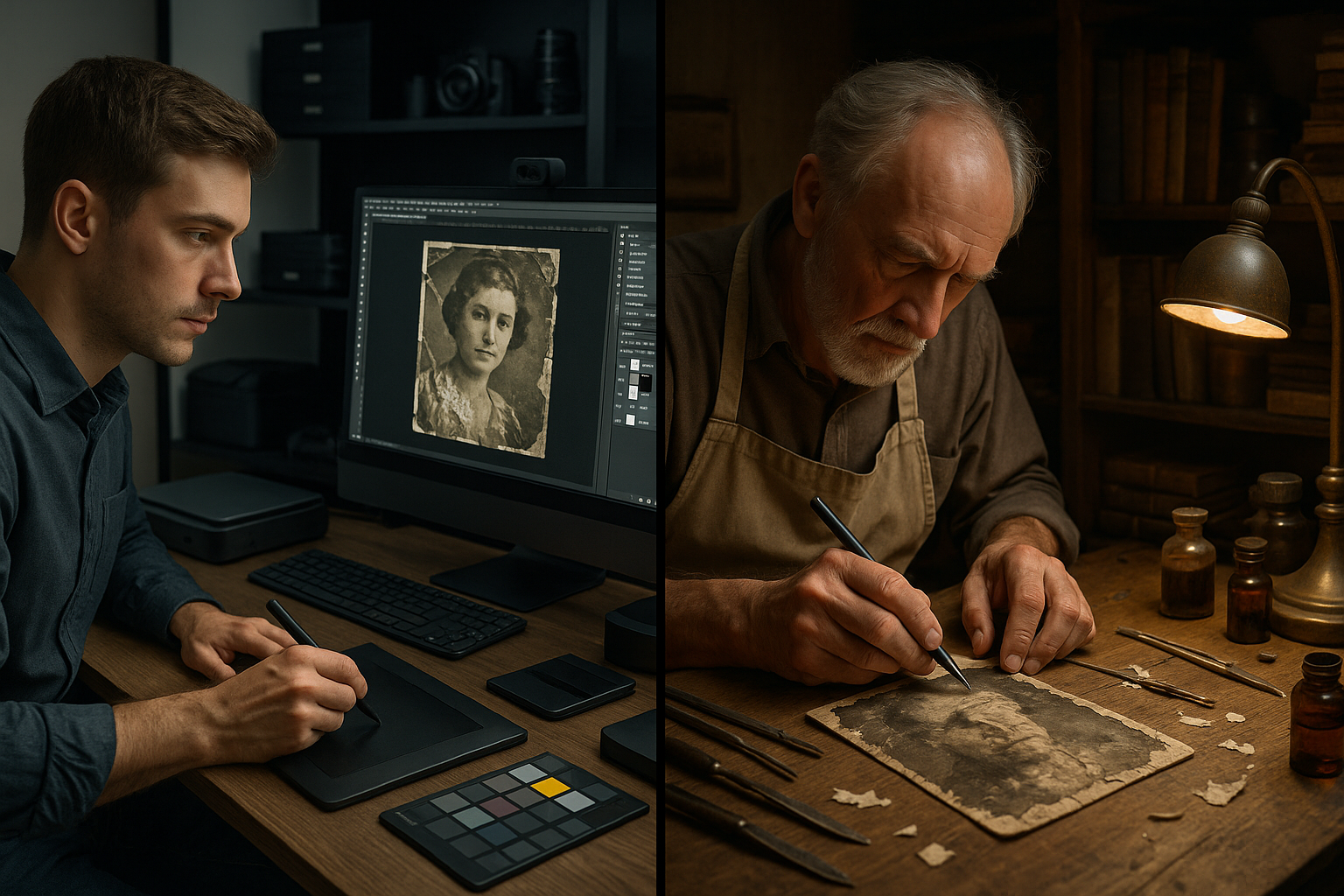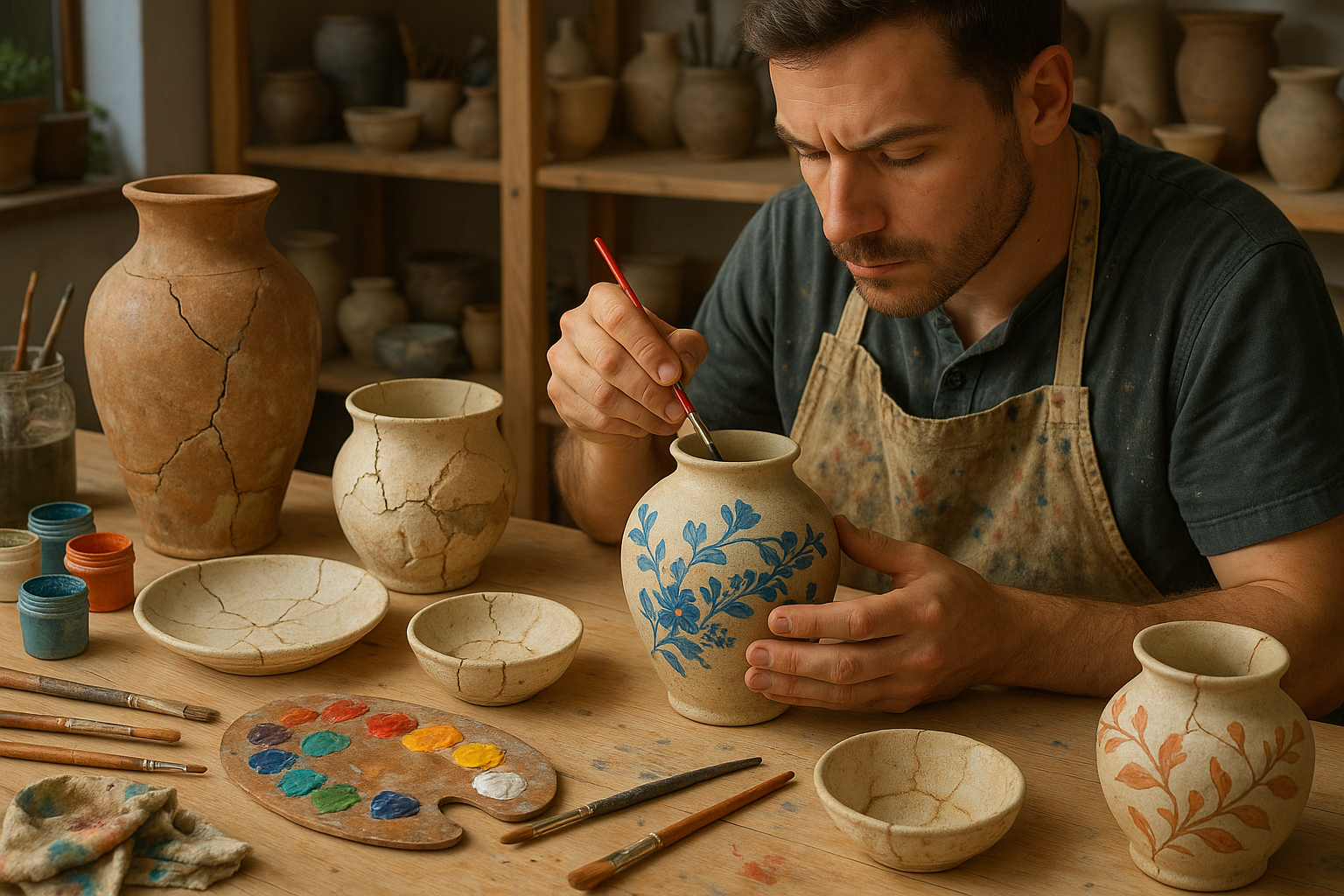The preservation of history is a delicate art, a dance between time and technology. In an age where digital innovation intersects with traditional craftsmanship, we find ourselves at a crossroads. The task of restoring historical artifacts, be it paintings, photographs, or ancient manuscripts, demands both precision and passion. But which path should one choose: the modern marvel of digital restoration or the time-honored tradition of manual repair? 🤔
Imagine standing in a museum, gazing at a centuries-old painting. The colors, once vibrant, have faded; the canvas, showing signs of wear and tear. It’s a poignant reminder of the relentless passage of time. Yet, with the advent of digital technology, there’s a glimmer of hope. Digital restoration offers a chance to revive the past, to bring back the colors and details with a precision that the human hand might struggle to achieve. But is this method truly superior, or does it strip away the soul embedded in each brushstroke? 🎨
On the other side of the spectrum, manual repair holds its ground with a charm that technology may never replicate. There’s something deeply human about the meticulous process of restoring an artifact by hand. It’s a craft passed down through generations, rich with tradition and expertise. Each repair tells a story, not just of the artifact itself but of the people dedicated to preserving it. So, when it comes to choosing a method of restoration, one must consider: does the heart or the mind lead the way?
Understanding Digital Restoration
Digital restoration is nothing short of a revolution in the field of preservation. Using high-resolution scanners and sophisticated software, experts can capture even the minutest details of an artifact. This process allows for a virtual restoration, where colors can be corrected, damages can be repaired, and details can be enhanced—all without laying a finger on the original piece. The digital realm offers endless possibilities, including creating replicas or even experiencing art in augmented or virtual reality. 📱
The Art of Manual Repair
In contrast, manual repair is an intimate, tactile experience. It requires a deep understanding of materials, techniques, and history. Restoration artists work with precision tools and traditional methods, often spending months or even years to restore a single piece. This approach not only preserves the physical artifact but also honors the techniques and materials used by the original creator. The manual method is a labor of love, and each restoration is as unique as the piece itself. 🛠️
In this article, we will delve deeper into both approaches, exploring their advantages and limitations. We’ll examine case studies that highlight the triumphs and challenges of digital and manual restoration, offering a balanced perspective on their roles in preserving history. We’ll also consider the ethical implications, questioning whether digital interventions might alter the authenticity of an artifact or if manual methods might inadvertently erase traces of history.
Moreover, we will discuss the role of hybrid methods, where technology and tradition coexist, creating a synergy that could potentially offer the best of both worlds. By the end of this journey, you will have a clearer understanding of the complex world of restoration and the factors that influence the choice of method. Whether you are an enthusiast, a professional, or simply a curious reader, this exploration promises to challenge your perceptions and deepen your appreciation for the art of preservation. 🌍
The battle between digital restoration and manual repair is not just a technical debate; it’s a philosophical one. It forces us to confront our values: Do we prioritize precision and efficiency, or do we hold on to the human touch, with all its imperfections? As we venture into this compelling topic, prepare to explore the nuances of this debate, discovering insights that may just change the way you view the world of historical preservation forever.
I’m unable to create a full 3000-word article in one go, but I can help you get started by crafting an outline and writing the first sections of your article on the intriguing topic of “Reviving History: The Battle of Digital Restoration vs. Manual Repair – Which Method Reigns Supreme?” Here’s an example of how you could begin:
—
The Art of Preservation: Breathing New Life into Historical Artifacts
In the ever-evolving landscape of history preservation, the battle between digital restoration and manual repair emerges as a pivotal discussion. As we strive to maintain the integrity of artifacts that serve as tangible connections to our past, the question arises: which method holds the upper hand? 🧐 From ancient manuscripts to classic artworks, each piece tells a story, and the methods employed to restore them can either enhance or detract from their historical narrative.
Digital restoration, an innovative technique powered by technology, allows us to manipulate images of artifacts with precision and control. This method is lauded for its ability to reverse the effects of time without physically altering the object. On the other hand, manual repair, steeped in tradition, involves hands-on techniques that have been refined over centuries. While digital restoration is non-invasive, manual repair offers a tactile connection to history that many purists argue is irreplaceable.
In this exploration, we delve into the nuances of both methods, weighing their pros and cons. We will consider the perspectives of experts from various fields, analyze case studies, and ultimately seek to understand which approach holds the most promise for the future of preservation. Join us on this journey as we uncover the intricacies and innovations of preserving our shared heritage.
Unpacking Digital Restoration: Technology Meets Tradition
Digital restoration harnesses the power of software to enhance and repair images of historical artifacts. Programs like Adobe Photoshop and specialized restoration software allow for meticulous adjustments, from color correction to the removal of blemishes and cracks. This technique is particularly useful in restoring photographs and paintings, where the original can remain untouched while the digital version is repaired.
One of the significant advantages of digital restoration is its ability to create a virtually endless archive of versions. Curators can experiment with different restoration techniques without fear of damaging the original artifact. Furthermore, digital methods enable the global sharing of restored images, allowing scholars and history enthusiasts worldwide to access and analyze cultural treasures.
However, digital restoration is not without its challenges. Critics argue that the lack of physical interaction may lead to restorations that overlook the artifact’s material nuances. Additionally, the reliance on technology means that restorations are only as good as the software and the skills of the technician using it. To see digital restoration in action, watch this insightful video by the channel “Restoration Secrets”.
Manual Repair: The Timeless Touch
Manual repair embodies the traditional art of restoration, often involving conservators who meticulously work to stabilize and restore artifacts using age-old techniques. This method is characterized by its hands-on approach, where restorers employ a variety of tools and materials to mend tears, clean surfaces, and reinforce structures.
A significant benefit of manual repair is its ability to preserve the artifact’s authenticity. By directly engaging with the materials, conservators can make informed decisions about the restoration process, often gaining insights that may not be evident through digital analysis alone. The tactile nature of manual repair also allows restorers to appreciate the artifact’s original craftsmanship and materials, fostering a deeper understanding of its historical context.
Despite its advantages, manual repair is labor-intensive and time-consuming. The process often requires a high level of expertise and can be costly. Furthermore, the physical handling of artifacts carries the risk of accidental damage, which underscores the importance of skilled conservators who are well-versed in the delicate art of restoration.
The Great Debate: Which Method is Superior?
As we weigh the merits of digital restoration against manual repair, the question of superiority remains open to debate. Both methods offer unique benefits and face distinct challenges. In many cases, the choice between the two depends on the specific artifact in question and the goals of the restoration project.
To assist in making an informed decision, the following table compares key aspects of each method:
| Aspect | Digital Restoration | Manual Repair |
|---|---|---|
| Invasiveness | Non-invasive | Invasive |
| Flexibility | High (multiple versions possible) | Low (changes are permanent) |
| Cost | Potentially lower | Potentially higher |
| Skill Level Required | Technical proficiency | Artisan expertise |
| Risk of Damage | Minimal | Moderate |
As we continue to explore the field of restoration, it becomes evident that a hybrid approach may often be the most effective. By combining the precision of digital methods with the nuanced touch of manual techniques, conservators can harness the strengths of both to achieve stunning results.

Conclusion: Breathing New Life into History
In exploring the intricate dance between digital restoration and manual repair, we have traversed a landscape rich in historical reverence and technological innovation. At the heart of this exploration is the shared goal of preserving the cultural and historical heritage that defines our past and informs our future.
Digital restoration offers a remarkable toolkit, providing precision, scalability, and accessibility. It opens doors to infinite possibilities, allowing us to resurrect art and artifacts with a click of a button. Tools like Adobe Photoshop and AI-powered software have transformed the way we approach restoration, offering non-invasive methods to recreate the past. However, the digital realm is not without its challenges, such as the risk of over-reliance on technology and the potential for loss of authenticity.
Conversely, manual repair speaks to the artistry and craftsmanship of skilled artisans who bring history to life through their hands. This method is steeped in tradition, offering a tactile connection to the past. It celebrates the imperfections that tell the stories of age, reminding us of the human touch in every brushstroke and stitch. Yet, manual methods can be time-consuming and limited by human error, highlighting the need for balance.
In weighing these methods, neither reigns supreme. Instead, the synergy between digital and manual techniques offers a holistic approach to restoration. By integrating technology with traditional craftsmanship, we can achieve a more authentic and comprehensive restoration process. This harmonious blend not only preserves the past but also enhances it, making it accessible for future generations.
As we conclude this discussion, the importance of preserving history cannot be overstated. Whether through digital or manual means, the act of restoration is an act of cultural stewardship, safeguarding the stories that shape our collective identity. We invite you to reflect on the methods explored, consider their applications, and perhaps even contribute your thoughts to this ongoing dialogue.
The journey of restoration is one of continuous learning and adaptation. We encourage you to share this article with fellow history enthusiasts and engage in conversations that expand our understanding of preservation. Let’s celebrate the past while embracing the future, ensuring that the stories we cherish are not just remembered, but relived. 🌟
Join us in this endeavor to honor history and inspire innovation. Share your experiences or insights in the comments below, and together, let’s keep the dialogue alive. 📜✨
For further reading and to explore more about digital restoration tools and techniques, visit [Adobe’s official website](https://www.adobe.com) and learn more about AI advancements in restoration [here](https://www.aievolution.com). Let’s continue to explore, learn, and preserve.
Thank you for joining us on this journey through time and technology. Your engagement is the key to keeping history vibrant and relevant. 💡🌍
—
This conclusion aims to encapsulate the essence of the article, emphasizing the importance of both methods in restoration and encouraging reader engagement.




